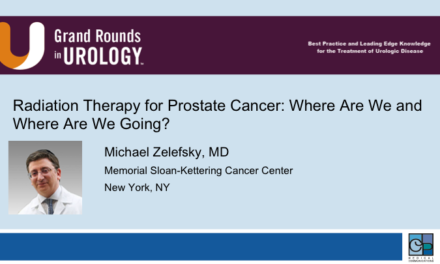Dr. Marc B. Garnick spoke at the 25th International Prostate Cancer Update on Friday, January 23, 2015 on “LHRH Agonists: An Analysis of Where We Have Been, Where We Are, and Where We Are Going.”
Keywords: LHRH agonists, GNRH antagonists, hormonal therapy, prostate cancer
How to cite: Garnick, Marc B. “LHRH Agonists: An Analysis of Where We Have Been, Where We Are, and Where We Are Going” Grand Rounds in Urology. March 17, 2015. Accessed Dec 2024. https://dev.grandroundsinurology.com/prostate-cancer-marc-b-garnick-lhrh-agonists/.
Transcript:
LHRH Agonists: An Analysis of Where We Have Been, Where We Are, and Where We Are Going
What I want to try to do in the next few minutes is to show the landscape at the time LHRH agonists were in utero; talk about some cardiovascular issues; some glucose and cholesterol abnormalities; and the future role of LHRH agonists. I’m going to try to provide for you a perspective of things that may or may not come across your radar screen in the day-to-day management of your patients with LHRH agonists.
As you know, LHRH is a decapeptide and the agonist basically have substitutions in the 6 amino acid position with a d-amino acid which basically precludes peptidases in the circulation from breaking them down, allowing them to basically sit on the LHRH receptor and do what they end up doing.
Antagonists such as abarelix and degarelix basically have multiple non-natural occurring amino acids and that’s a structure of these particular agents. But all of the agonists basically have substitutions in the 6 position with a d-amino acid.
As you know, this group would obviously know that the administration of an LHRH agonist causes stimulation of the LHRH GnRH receptor that leads to stimulation of LH and FSH or initially increasing testosterone. Over a period of time that receptor becomes desensitized leading to decreases in LH, decreases in testosterone, and then initial decrease in FSH actually starts to increase. These are really LHRH agonists as opposed to an antagonist, which we should call a GnRH antagonist because it affects not only LH, but also FSH.
Here’s the mechanism of action of antagonist, basically immediately shutting down the GnRH receptor leading to a decrease in LH, FSH, which is sustained during the course of treatment.
Just imagine it was 1980 to 1985, and I’ve shown this slide many times. CT scanning was in its infancy. MRI was not even called MRI at that point. It was called nuclear magnetic resonance, and that scared a lot of patients because they did not want to have tests that included nuclear in its title. There were no supportive cardiovascular therapies such as statins. Prostate biopsies were done with Vim-Silverman needles, very, very large needles, and basically as a comment to the discussion yesterday, there is a literature on patients with “stage C disease which were called T3 disease that was high grade disease that actually had large bore biopsy needles that actually were associated with tumor tracking. We did have acid phosphatase, radionuclide bone scans, DES, lymphangiography, hypophysectomy, surgical castration, the early aromatase inhibitors–which were the prelude to drugs such as abiraterone in the form of aminoglytethimide–and “last ditch” chemotherapy.
Today we have just a wide spectrum of novel agents that’s too numerous to list here, but there’s just a wide array of agents that we have and we’re trying to figure out how to use them in the appropriate management of our patients.
The leuprolide DES study, and my special thanks to go to Mike Glode and Jay Smith, who along with me presented this information to the FDA that ended up getting this product approved. But just take a moment to look at the other investigators, many of whom have been mentioned in this meeting and it’s really quite an august group of people involved with that study back in the 1980s.
This was leuprolide that was given subcutaneously versus a comparator 3 mg of diethylstilbestrol. Very, very small patient study, less than 200 patients total. The follow up at the time of the submission was actually one year of actual survival data that included 87% Lupron, and 78% in DES. Obviously those numbers would be much different today because this was a much higher risk patient population.
In terms of the best response to therapy, similar complete, partial, and no change responses. Progressive disease a little bit worse for Lupron. Adverse events substantially worse in the DES population.
The product really got approved by virtue of its similar efficacy and its improve safety profile. Hot flashes were substantially more prominent than Lupron but in contrasts gynocomastia or breast tenderness, nausea and vomiting, peripheral edema, and thromboembolic phenomenon were significantly greater except for thromboembolic phenomenon, which almost reached statistical significance. It was based upon this that the FDA granted approval in 1984.
The next major component of LHRH therapy goes to Dr. Crawford, and the famous Lupron placebo versus Lupron plus flutamide study. This is a look at the overall survival, and this really sort of established combined androgen blockade as an appropriate first-line therapy for patients with metastatic disease.
Subsequent studies of Lupron done in our own company was Lupron versus the antagonist Plenaxis and you can see the testosterone surge is completely abrogated with an LHRH antagonist or GnRH antagonist, and regardless of whether or not you use monotherapy or monotherapy plus… or a combined therapy, the testosterone surges is not abrogated with the concomitant administration of an anti-androgen. Many physicians don’t really appreciate that.
Just a comment here. We were actually the first to show chronically the administration of an antagonist could cause suppression of FSH, and I know the degarelix people showed their slide, but actually we published this in 2000 to show that with chronic administration of an antagonist whether or not it’s compared to an agonist with or without an antiandrogen, there was a substantial difference in FSH levels with the antagonist compared to the agonist.
The evolution of LHRH angonist went from daily subcutaneous to 4 weekly to 12 weekly, to 16 weekly, to 24 weekly, to yearly. I really caution you that in data that I’m going to present in a moment, 4 weekly is not monthly, and 12 weekly is not every three months. Basically patients need to get on a 4 weekly 13 doses during the year, and the 12 weekly really should be given every 85 days as opposed to 91 to 92 days and the reason for that will become evident. These formulations were really destined and made to fit into a weekly schedule, a multiple weekly schedule as opposed to a monthly schedule.
Where are the uses of LHRH analogs today? Clearly they’re used in the initial management of metastatic disease, prostate gland volume reduction prior to brachy primary therapy, with or without radiation in older patients. And there’s some very recent data to suggest that to get good results even in the elderly patients, you want to include radiation. Curative therapy with radiation therapy for T3 disease, biochemical relapse and it’s the main state during add-ons for metastatic castrate resistant disease. And believe it or not, we’re now in our 32nd year of use of Lupron which is sort of a record of sorts.
But what are the deficiencies of the available current, of the available analogs? I’m going to mention a few. The first is what we call inadequate gonadotropin suppression. This basically escapes from testosterone suppression and inadequate gonadotropin reserve. They’re common, the function of how frequently they occur actually is a function of how often you measure it. There’s also a phenomenon that we call “acute on chronic.”
The acute on chronic is basically despite the fact that the receptor is desensitized when you come in with a peptitic challenge, the receptor is able to actually express its activity normally in increased levels of LH and FSH. This is a so-called acute on chronic phenomenon. The data initially done with Zoladex, or goserelin, basically after 12… 6 months of therapy, one would get micro surges of LH and testosterone, with some values of testosterone going to above 200 ng. Here are the original data from that BMJ paper.
Testosterone escapes, not terribly well published but certainly studied in regulatory documents. If one takes a look at the summary basis of approval of either Lupron three month depot or goserelin three months depot, if you take a look at those patients that did not suppress, had acute or chronic or had isolated escapes, 16% to 17% of patients with a three month depot will end up experiencing that in addition to a 12.5% to 13% of patients on Zoladex will have very, very similar escapes from therapy. The three and four month depots are not three and four months, they’re really 84 and 112 day depots. You want to retreat at day 84 as opposed to every three months. In my own practice, I’m in a complete minority, I essentially only use the four week Lupron depot for the use of… when I select an LHRH agonist because of the other aspects.
A few comments relating to cardiovascular considerations. I’ll make a few comments about QT, metabolic abnormalities, coronary disease, and a recent literature that’s describing what’s called chronic kidney injury, which I’m not going to spend a lot of time on but it’s sort of out there, and I think it’s a subject that needs to further study.
You all know what the QT is. Prolongation of a QT can lead to pro-arrhythmic situations leading to torsade de pointes. When we were developing the GnRH antagonist abarelix, it came to our attention that there was prolongation acute TC interval and that caused a wide spectrum of investigations. And to make a long story short, it turns out that androgen ablation is associated with prolongation of the QT interval. If we take a look at three randomized studies, the prolongation of QT with LHRH alone is around 18 ms, with a combination about 9 to 10 ms, with antagonists just around 13 ms, and virtually identical data has been seen with the degarelix label. And based upon the work that we did, the FDA basically started to use the QTC label as a class label for all therapies that decrease androgen levels.
In terms of hormones, glucose, hemoglobin A1c and lipids. Data again from our own study showed that androgen deprivation was associated with lipid, hemoglobin A1c, independent of statin therapy. The greatest changes were in the cholesterol moieties and the other, so that was our study from looking at a variety of agents with LHRH analogs or antagonists. Two key papers for hormonal therapy in the heart are from Keating and Nado. Just be aware that increased levels of diabetes, increased incidence of cardiovascular disease during androgen deprivation occur in the population of patients that you’re treating on a day to day basis. And the hormonal therapy in prostate cancer in men undergoing–who have preexisting coronary disease are also substantially increased when patients go on LHRH analog therapy.
Here are the findings from the Keating study, diabetes increased, incident coronary heart disease. Here are the hazard ratios, MIs, there’s the hazard ratio, sudden cardiac death, and stroke. So these are significant evaluations and in the past we would just basically say that these patients were elderly and they had pre-existing coronary disease. I think LHRH agonists or androgen deprivation therapies can certainly add to that.
The Nando study, basically if you did not have pre-existing coronary disease, you seem to be risk-free from developing those. However, if you did have pre-existing coronary or congestive heart failure, your risk… for all cause mortality was substantially greater when placed on an LHRH agonist. The implications for practice are pretty straightforward.
I just want to end my story with some other pearls about LHRH agonists that I’ve sort of accumulated in the last 35 to 40 years of using these agents. Arthralgias are extremely common, about 4% to 5%. Usually they don’t require drug discontinuation but you should ask your patients if they’re having athralgias and myalgias. It’s not uncommon at all, and most people can sort of work through it. Cognition is a definite issue and especially in the brain active individuals, physicians, accountants, lawyers people that are using their brains all the time will really complain that their mental acuity is substantially–can be decreased when on an agonist. Transaminitis is much more common than you would ever expect. If you look for elevations in transaminases, you will find them in about 4% to 7% of patients independent of anti-androgen use. If the patient experiences acute headaches, visual changes in the first injection post-therapy, think of pituitary apoplexy. For patients who have high body mass indexes, who are not suppressed with testosterone, because don’t forget one dose fits all sizes of patients, think about increasing the frequency of dosing duration. And I’ve got a series of patients that I’m going to report at one time in which we can actually recapture those patients.
Then for those people that only use longer acting depot, try patients with a 4 week depot first, and then switch them to the 12 week or the 16 week depot and ask them how they feel after the 4 week depot versus the 12 to 16 week depot, and you’ll be amazed at the responses that you get.
Last few comments about hormonal therapy, and this immune reconstitution agent, and just be aware that with administration of LHRH agonists, you actually can increase thymic production and immune cells in the thymus and that may be a mechanism for improving outcomes of patients who end up having a beneficial effect when hormonal therapy is added to radiation or even with immune therapies.
The future of LHRH agonists in my opinion is it’s a remarkable class of drugs in its fourth decade. The chronic administration of agonists accompany nearly the treatment design for every novel hormonal therapy and non-hormonal therapy in the castrate resistant population. That’s never really been well studied but it’s a common practice, and I did not even show the anecdotal data to support it. There’s a remarkable safety profile over decades of use but we need to be very, very vigilant on the cardiovascular and obviously bone health issues. The future primacy of agonists versus antagonists is still being emerged. I actually think the optimal way of using these agents is to utilize an antagonist first for the first several months followed by a switch to an agonist and we’ve actually published information relating to that, and there’s continued expanding non-cancer uses for these agents so thank you very much for your attention.
ABOUT THE AUTHOR
Dr. Garnick is the Gorman Brothers Professor of Medicine at Harvard Medical School and the Beth Israel Deaconess Medical Center, where he also directs the hospital’s role as a tertiary cancer center for 7 affiliated community cancer centers. He has dedicated his career to the development of new therapies for prostate cancer. He serves as the Editor-in-Chief for The Annual Report on Prostate Diseases, formerly Perspectives on Prostate Disease. He served as the initial academic co-principal investigator for the commonly used prostate cancer drug leuprolide (Lupron). In addition to his academic affiliations, Dr. Garnick founded the Hershey Family Foundation for Prostate Cancer Research at Beth Israel Deaconess Medical Center, serves as medical adviser to World Book Encyclopedia, and is an active advisory member of several FDA panels and advisory committees. He has served on the boards of trustees of the Perelman School of Medicine at the University of Pennsylvania and of Penn Medicine. Dr. Garnick is also a Trustee Emeritus of Bowdoin College in Brunswick, Maine.





